
Kamienne koleiny w "mieście Midasa" w Turcji
Historia kolei
29 stycznia 2021

Kamienne koleiny w "mieście Midasa" w Turcji
Do 1825 roku zarówno wygląd zewnętrzny, jak i parametry techniczne pociągu ulegały ciągłym zmianom. Pojawienie się kolei szynowej wyznaczyło początek nowoczesnego świata: ery masowych podróży, efektywnego transportu ładunków na znaczne odległości, szybkiej dystrybucji dóbr, a także informacji na skalę krajową i międzynarodową. Czasem trudno uwierzyć, że historia kolejnictwa zaczęła się od wozów ciągniętych po wyżłobieniach…
W skrócie
Wyżłobień w kamiennych płytach dróg używali już starożytni. Pierwsi na ten pomysł wpadli Asyryjczycy i Grecy, którzy przez ponad sześćset lat wykorzystywali po kamiennych koleinach przeciągali statki w poprzek Przesmyku Korynckiego. Na mocno uczęszczanych drogach dojazdowych do Rzymu, koleiny tworzyły się same, gdzie indziej – żłobił je człowiek. Na przełomie średniowiecza i nowożytności pojawiły się szyny drewniane. Wynalazek ten cały cza próbowano ulepszyć. Wykorzystywaną głownie w kopalniach formę transportu na powierzchnię wydobyła rewolucja przemysłowa, a ta zaczęła się od Wielkiej Brytanii. To tam po raz pierwszy nikomu nie znana kolej stała się publicznie dostępnym środkiem transportu.
Pokrycie kontynentów siecią linii kolejowych sprawiło, że każdy człowiek, którego stać było na bilet, mógł szybko i wygodnie dotrzeć do miejsc, wcześniej dostępnych jedynie dla zahartowanych wędrowców. Dzięki pociągom ogromne odległości na lądzie szybko i sprawnie pokonywały nie tylko rzesze ludzi, ale i tony towarów. Żaden zaprzęg nie był w stanie zabrać tyle ładunku, co wagony kolejowe. Możliwości, jakie daje masowy transport ludzi i towarów, przyspieszyły rozwój miast, regionów, fabryk. Tak więc historia transportu szynowego to jednocześnie historia postępu.
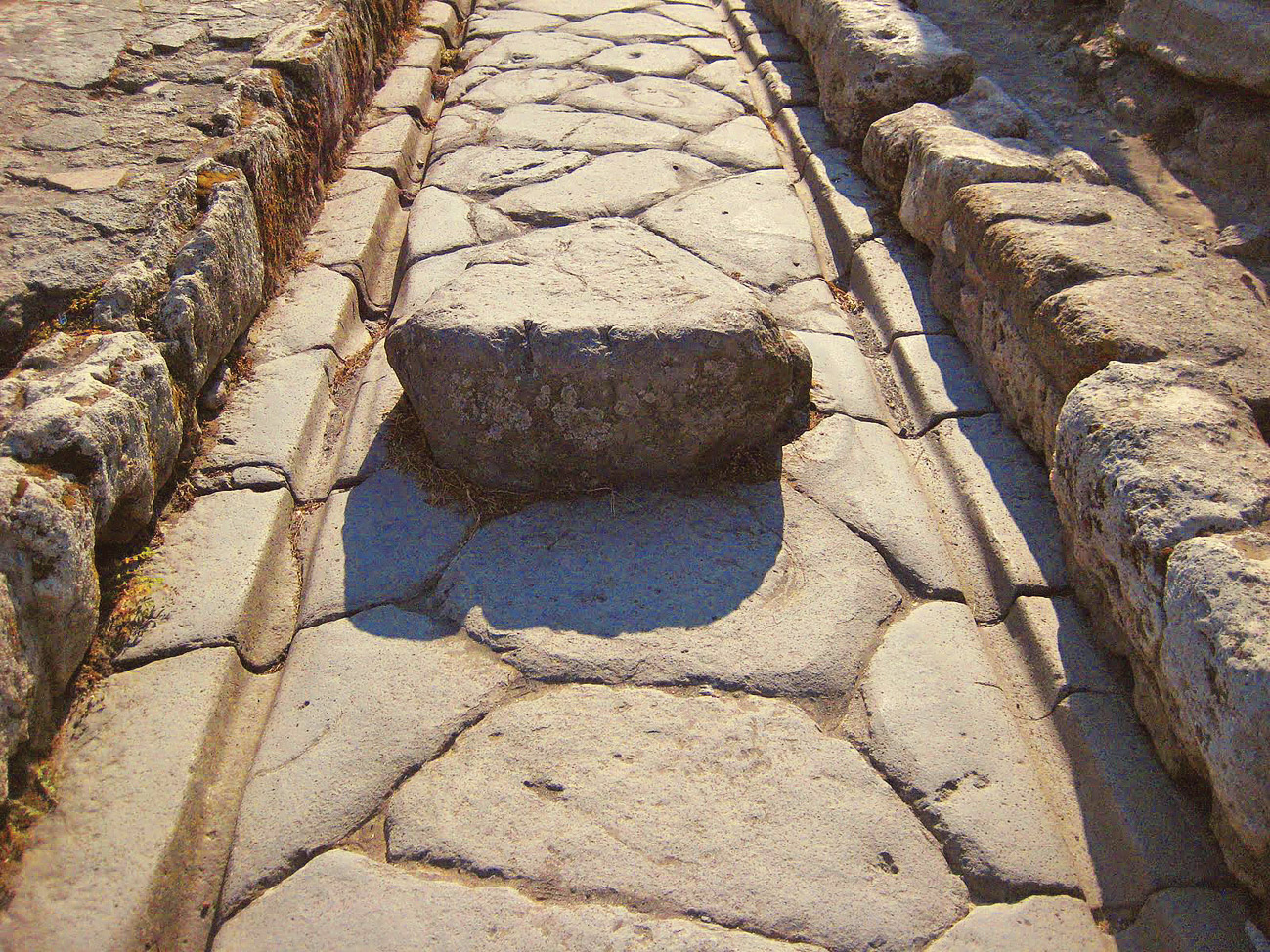
Kamienne koleiny w starożytnej drodze w Pompejach
Po kamiennych szynach
Kolej nie jest wynalazkiem jednego człowieka. Do jej powstania przyczyniło się wielu konstruktorów. Prapoczątki idei transportu na szynach sięgają starożytności, o czym świadczą, zachowane do dziś, ślady kamiennych torowisk. Rzemieślnicy wyciosywali w kamiennych drogach koleiny, w które wstawiano koła pojazdów. Sprawdzały się one szczególnie w górach i na krętych szlakach, wozy nie zbaczały bowiem z trasy, nie przechylały się na boki, nie zsuwały się ze stromych dróg i można je było bezpiecznie prowadzić przez zakręty. Odległość między koleinami była dopasowana do, przyjętego w danej okolicy, rozstawu kół pojazdu i – zależnie od regionu – wahała się od około 1350 mm do 1500 mm. Prawdopodobnie od rozstawu jednych z takich kolein, pochodzi zastosowany już w 1630 roku i najbardziej rozpowszechniony na świecie, rozstaw normalnotorowy mierzący 1435 mm.
Prawo silniejszego na mijance
Zdecydowana większość dróg posiadała tylko jedno pasmo ruchu, dlatego urządzano na nich, w pewnych odstępach, mijanki, aby umożliwić przejazd pojazdom zdążającym w przeciwnych kierunkach. Jeśli spotkanie takie następowało pomiędzy wyznaczonymi do tego celu i specjalnie poszerzonymi odcinkami, mniej dostojny albo po prostu słabszy z podróżnych, musiał wycofać swój zaprzęg do najbliższej mijanki lub usunąć go na chwilę na pobocze drogi. Często dochodziło na tym tle do zatargów, a nawet pojedynków – nie każdy bowiem chętnie dawał innym pierwszeństwo. W greckim micie o Edypie, bohater – nie chcąc ustąpić z drogi – zabił, jadącego z naprzeciwka, nieznajomego starca, w rzeczywistości swego ojca, Lajosa. Przytoczony epizod pośrednio dowodzi istnienia w starożytnej Grecji szlaków koleinowych. Z czasem nawierzchnię dróg zaczęto wykładać, na całej szerokości, płytami kamiennymi, co eliminowało koleiny. Sposób przemieszczania się, który niegdyś stosowano, powrócił dopiero po upływie wielu stuleci.
Turkot kół na drewnianym torze
Tor – jaki znamy – wywodzi się zapewne z desek, układanych na piaszczystym lub błotnistym gruncie po to, aby nie grzęzły koła naładowanych taczek czy wózków. Przypuszczalnie układali je już nasi średniowieczni przodkowie, wznoszący monumentalne zamki i katedry. Prowizoryczne „tory” z desek można zobaczyć również współcześnie, np. na placach budowy.
Prawdziwy tor powstał jednak nie na placu budowy, lecz pod ziemią. Torowiska prymitywnej konstrukcji budowane były najpierw w kopalniach węgla i rud żelaza – dla kolejek konnych i wózków transportowych, napędzanych siłą mięśni człowieka. Rolę szyn spełniały wówczas, utwardzane drewnem, naturalne koleiny. Najczęściej jednak budowano z desek rynienki, w których biegło dodatkowe, piąte koło umieszczone na przedzie pojazdu. Później używano do tego celu drewnianych belek. Wykonane z nich szyny były przybite do ułożonych w poprzek, również drewnianych, podkładów. Po takich torowiskach, w małych wagonikach, transportowano ze sztolni węgiel kamienny i rudy. Było to znaczne ułatwienie dla górników, którzy wcześniej cały urobek musieli na własnych plecach mozolnie wynosić na powierzchnię. W wąskich chodnikach chodziło nie tylko o zapadanie się kół górniczych wózków, ale również o wytyczenie drogi ze względów bezpieczeństwa. W ciemnościach, panujących pod ziemią, łatwo było najechać na ludzi lub inne wózki. Pierwsze tory, poza obrębem kopalni, powstały w Anglii około 1600 roku.
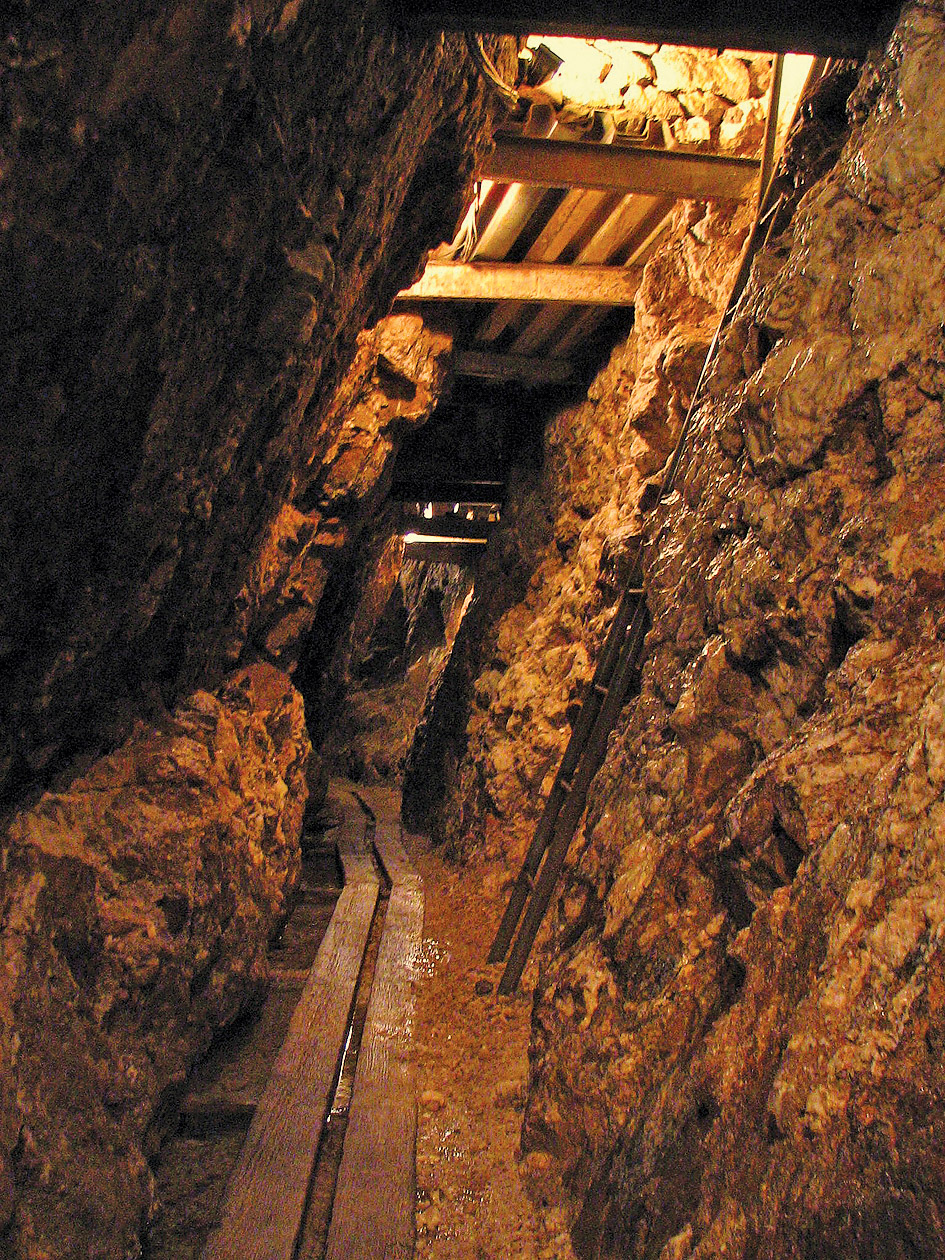
Zachowane do dziś drewniane tory w średniowiecznej kopalni srebra w Suggental w Niemczech
Konie, zaprzężone do wypełnionych węglem lub rudą wagoników, ciągnęły je do najbliższej rzeki, kanału albo do brzegu morza, gdzie przeładowywano urobek na statki. Jeden koń pociągowy był w stanie przetransportować tyle węgla, ile przenosiło aż 30 koni jucznych. Z czasem drewniane tory zaczęto stosować również do przewozu innych materiałów, np. wyrobów z fabryk czy bloków z kamieniołomów. Wiele wagoników posiadało koła ze specjalnym wybrzuszeniem po wewnętrznej stronie, dzięki czemu nie zsuwały się one z szyn i pozostawały cały czas na właściwym torze. Ten wynalazek można zaobserwować także i we współczesnych pociągach.
Materiał, z którego wytwarzano szyny w tym okresie, czyli drewno, miał poważne wady: po pierwsze, bardzo szybko się zużywał, a po drugie – nie można było nimi przewozić zbyt ciężkiego ładunku. Wkrótce wprowadzono pewne udoskonalenie, polegające na wzmacnianiu torów paskami blachy, które później pokrywano płytami z żelaza lub żeliwa.
Na polecenie Richarda Reynoldsa, właściciela huty, w 1767 roku odlano z żelaza długie, wąskie płyty, które przybito następnie do szyn. Po tak wzmocnionych torach można już było przewozić znacznie cięższe ładunki, a wagoniki toczyły się po nich z lekkością. Na decyzję Reynoldsa miał wpływ kryzys gospodarczy oraz związany z nim gwałtowny spadek cen wyrobów hutniczych. Wówczas dyrektor wielkich zakładów metalowych w Coalbrookdale postanowił wstrzymać wyprzedaż produkowanego tam żeliwa, aż do czasu ponownego wzrostu cen. Aby nie blokować magazynów, polecił wykorzystać tymczasowo żeliwne płyty do wzmocnienia należących do przedsiębiorstwa, drewnianych torów transportowych. Posunięcie to znacznie podniosło wytrzymałość torowisk i szybko zdobyło popularność.
Potem było żeliwo
Konstrukcja toru uległa zasadniczej zmianie w drugiej połowie XVIII wieku, kiedy do użytku weszła szyna żeliwna w kształcie litery „L”. W 1789 roku Anglik, William Jessop, użył szyny zbliżonej kształtem do dzisiejszej. Na żeliwnych torach postawił wagony wyposażone w koła z obrzeżami. Wkrótce jego wynalazek przywędrował do, największego wówczas na kontynencie europejskim, niemieckiego centrum gospodarczego na Górnym Śląsku. Tak powstała konna, przemysłowa kolej wąskotorowa, pierwsza na dzisiejszych ziemiach polskich i jednocześnie pionierska na kontynencie europejskim. Żeliwny tor zwiększył możliwości transportu o 10-15 razy. Na przełomie XVIII i XIX wieku powstawały więc liczne towarzystwa, które – na potrzeby przemysłu i handlu – podejmowały się budowy nowych kolei konnych. Szyny żelazne stosowano od 1820 roku, a stalowe od 1862 roku.
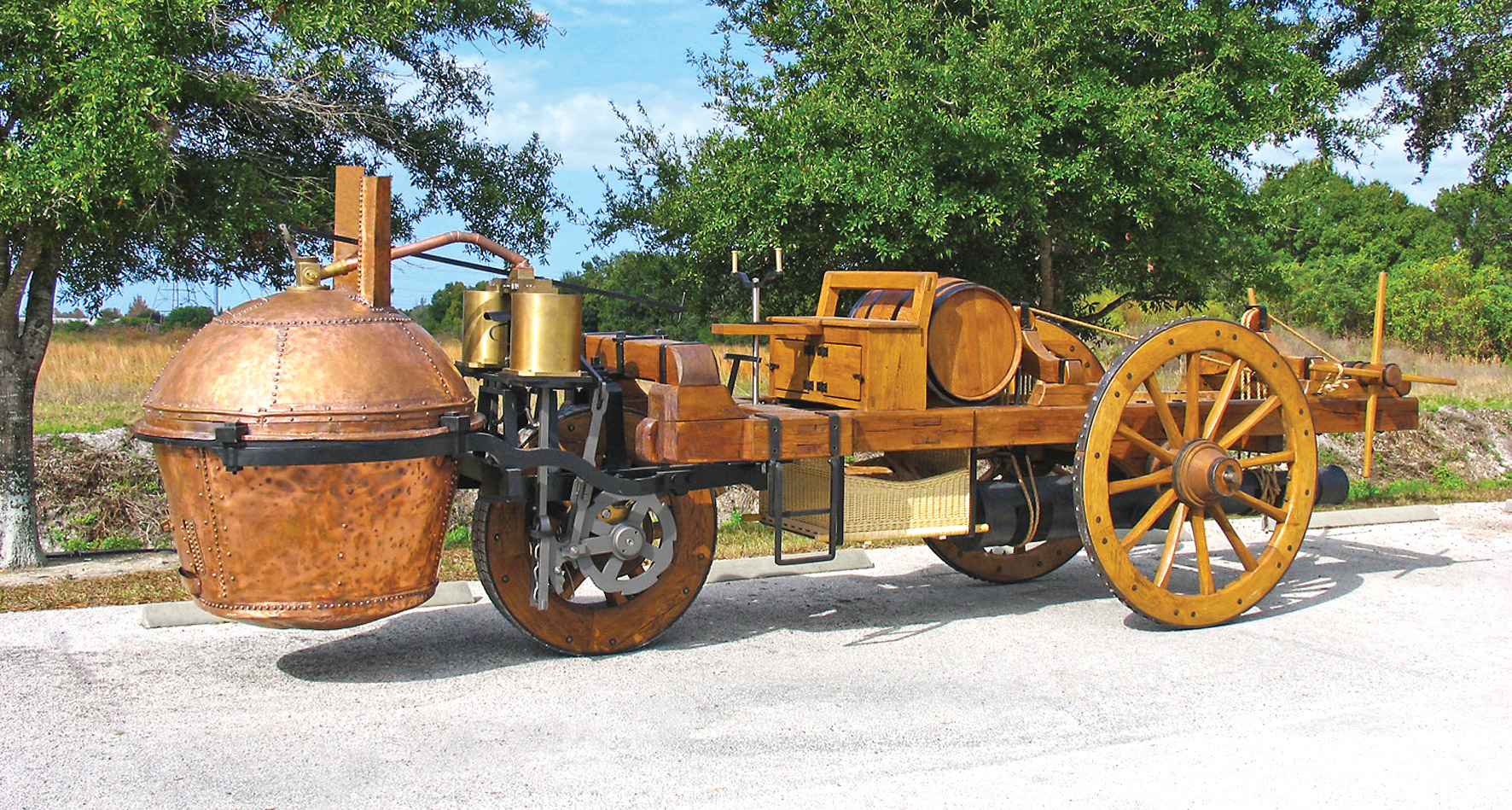
Pojazd napędzany parą wynaleziony w 1769 r. przez Nicolasa Josepha Cugnota
TRUDNE NARODZINY PAROWOZU
Za wynalazcę stacjonarnej maszyny parowej uważa się Jamesa Watta, który w 1763 roku udoskonalił atmosferyczny silnik parowy, zbudowany wcześniej przez Thomasa Newcomena. Wszystko rozpoczęło się od tego wydarzenia. Narodziny parowozu były trudne i obfitowały w dramatyczne następstwa.
Awaryjny trójkołowiec z wielkim kotłem...
W miarę powstawania coraz doskonalszych silników parowych znaleźli się fantaści, którzy zaczęli myśleć o zastosowaniu ich do napędu pojazdów. Bezpośrednim poprzednikiem lokomotywy parowej była konstrukcja Nicolasa Josepha Cugnota z 1769 roku. Ten francuski oficer postarał się w Ministerstwie Wojny Francji o zamówienie na ciągnik artyleryjski. Zainspirowany maszyną parową, stosowaną wówczas w kopalniach i fabrykach, ciągle doskonaloną przez Jamesa Watta, zapragnął zbudować pojazd napędzany siłą pary – podobny do konstrukcji opisanej już w 1663 roku przez angielskiego fizyka, astronoma i matematyka Izaaka Newtona. W 1769 roku zleceniodawcom został zaprezentowany wehikuł, wyposażony w trzy koła i wielki kocioł. Podgrzana w kotle woda wprawiała maszynę w ruch na około 10 minut. Po tym czasie trzeba było ponownie rozgrzać wodę, by kontynuować dalszą jazdę. Zachęcony tym osiągnięciem Cugnot umieścił pod kotłem palenisko, dzięki czemu pojazd jeździł dłużej z oszałamiającą prędkością 4 km/h. Niełatwo jednak było nim sterować, co stało się przyczyną pewnego incydentu. Podczas pokazu zorganizowanego dla wojskowych wyższej rangi, wynalazek wymknął się spod kontroli i ruszył w stronę obserwatorów, wywołując panikę i przerażenie, a następnie uderzył w mur. Po tym wypadku zrezygnowano z kontynuowania prac, gdyż uznano wehikuł Cugnota za zbyt niebezpieczny. Wokół pojazdów parowych na dłuższy czas zapanowała cisza.
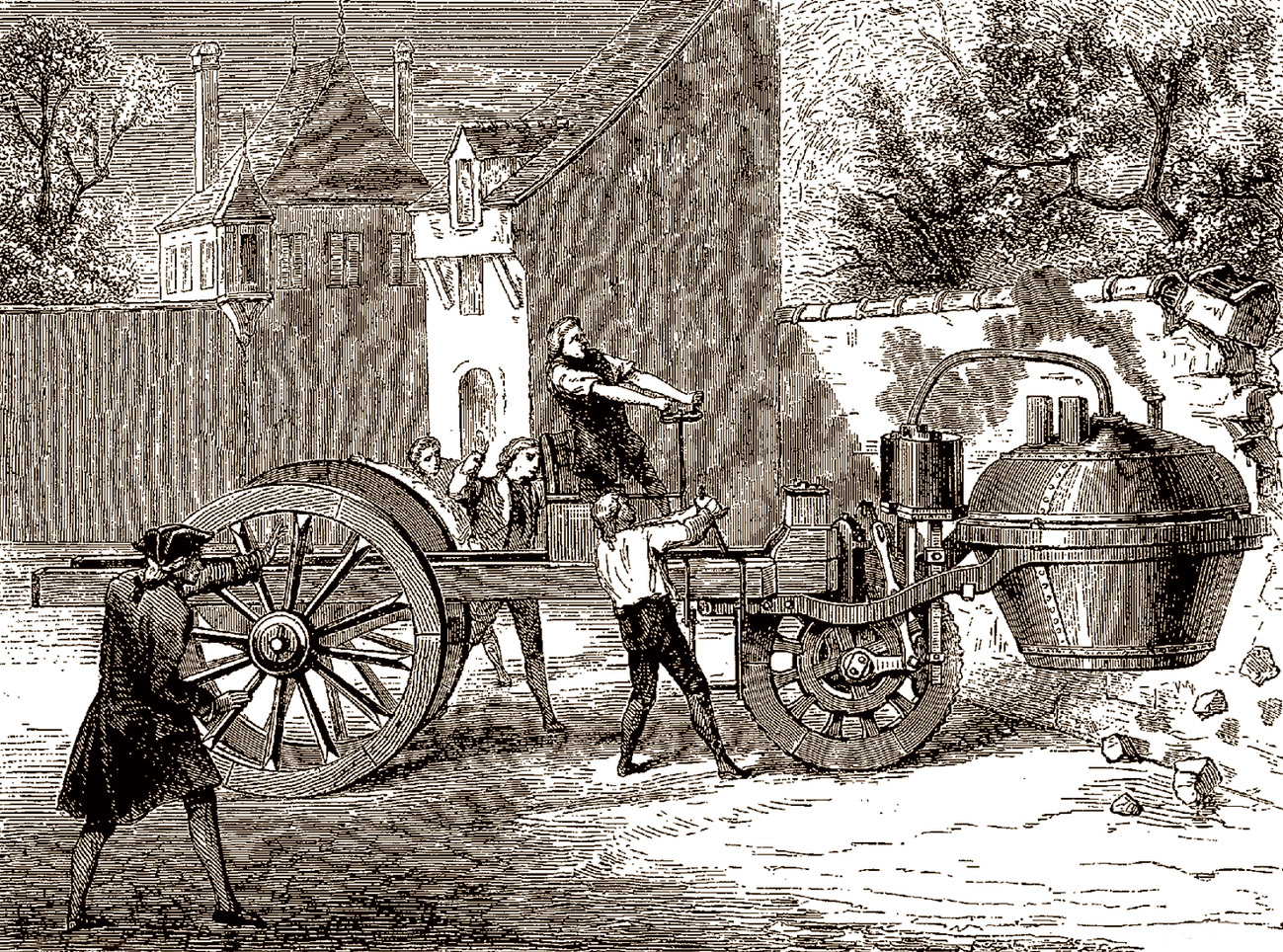
Nicolas Joseph Cugnot próbuje zatrzymać skonstruowany przez siebie pojazd napędzy maszyną parową podczas prezentacji w 1771 r.
... i inne wpadki prototypów
James Watt i inżynier William Murdoch również zajmowali się możliwością wykorzystania niskoprężnej maszyny parowej do napędzania pojazdu. Murdoch, który w 1786 roku wypróbował w miasteczku Redruth w Anglii, swój wynalazek z kotłem podgrzewanym lampą spirytusową, również napotkał trudności. Rozgrzał kocioł w ustawionej na środku ulicy maszynie, ale nie zdążył w niej zasiąść. Jadący bez kontroli parowóz przeraził miejscowego pastora, który doznał tak silnego szoku, że wkrótce zmarł.
Niebawem w warsztacie Murdocha pojawił się zdolny pracownik, Richard Trevithick, który stwierdził, że słabe ciśnienie w kotle nie wystarcza do napędu pojazdu, więc pojemnik należy uszczelnić, by podnieść ciśnienie do około trzech atmosfer. Próba, dokonana w wieczór wigilijny 1801 roku przez Trevithicka, zakończyła się niepowodzeniem. Parowóz, którym wraz z przyjaciółmi odbywał przejażdżkę, wywrócił się i wpadł do rowu. Nikt nie ucierpiał, nie uległa uszkodzeniu również maszyna, ale zdenerwowani wycieczkowicze zmienili plany i postanowili resztę wieczoru spędzić w pobliskiej gospodzie na suto zakrapianej kolacji. Pozostawiony w szopie parowóz spłonął. W 1803 roku w Londynie Trevithick zbudował nową maszynę. Poruszała się ona sprawnie po ulicach z prędkością 12 km/h. Ze względu na to, że płoszyła konie i przerażała przechodniów, była bojkotowana przez mieszkańców i prasę.
Ciężki parowóz i słaby tor
Pracując w zakładach metalowych Penydarren w południowej Walii, Trevithick namówił ich właściciela, Samuela Homfraya, do zbudowania maszyny parowej, będącej w stanie zastąpić konie, ciągnące wagoniki z towarami do odległego o 15 kilometrów Abercynon. Podczas inauguracyjnego przejazdu, który odbył się 22 lutego 1804 roku, zabrano pięć wagonów, 10 ton żelaza i 70 osób. Skład ciągnął pierwszy, nadający się do eksploatacji, parowóz z kołem zamachowym. Ciśnienie w kotle wynosiło już 4 atmosfery. Trasę o długości ponad 15 kilometrów pokonano w 4 godziny i 5 minut. Parowóz Trevithicka odbył na tej linii wiele kursów, ciągnąc nawet 25-tonowe ładunki. Pod ciężarem 5-tonowego parowozu i ładunków, tor zbudowany z lekkich szyn zużywał się. Z kolei po zmniejszeniu ciężaru pojazd tracił przyczepność i nie nadawał się do jazdy. Stwierdziwszy, że utrzymanie linii wymaga dużych nakładów finansowych, Homfray wycofał parowóz i przywrócił trakcję konną.
„Małżeństwo” lokomotywy z szyną
Richard Trevithick udowodnił jednak, że gładkie koło na gładkiej szynie stalowej może dać odpowiednią przyczepność. Zaryzykował jeszcze raz – w 1808 roku – uruchamiając w Londynie, na zamkniętej trasie, nową kolejkę, nazywaną „Catch me who can” („łap mnie, kto potrafi”). Był to okrężny tor kolejowy, na którym prezentował publiczności inny parowóz własnej konstrukcji. Amatorom niezwykłych wrażeń oferował, za opłatą 1 szylinga, krótką przejażdżkę pociągiem. Wpływy z biletów były jednak niskie, a ponadto, po ulewnym deszczu, zapadły się tory. W tej sytuacji Trevithick zamknął przedsiębiorstwo i porzucił zainteresowanie koleją. Do dziś jest uważany za konstruktora który zespoił ze sobą dwa podstawowe elementy kolei – lokomotywę z torem.
Kołem biznes się toczy
Próby zbudowania i wprowadzenia do użytku parowozów nie były wynikiem urzeczywistniania fantastycznych pomysłów XVIII- i XIX-wiecznych konstruktorów. To rozwój przemysłu i handlu wymuszał poszukiwania nowych środków transportu. Już w XVIII wieku, na ważniejszych szlakach, budowano coraz więcej mostów, utwardzano i poszerzano drogi. Ulepszona sieć komunikacyjna stopniowo uniezależniała zakłady przemysłowe od szlaków wodnych. Rozwój fabryk sprzyjał powstawaniu dużych przedsiębiorstw przewozowych. Jedna z takich firm w Londynie dysponowała w tym czasie 3 tys. wozów konnych i zatrudniała 30 tys. pracowników. We Francji przedsiębiorstwa tego typu przewiozły w 1840 roku ponad 700 tys. osób.
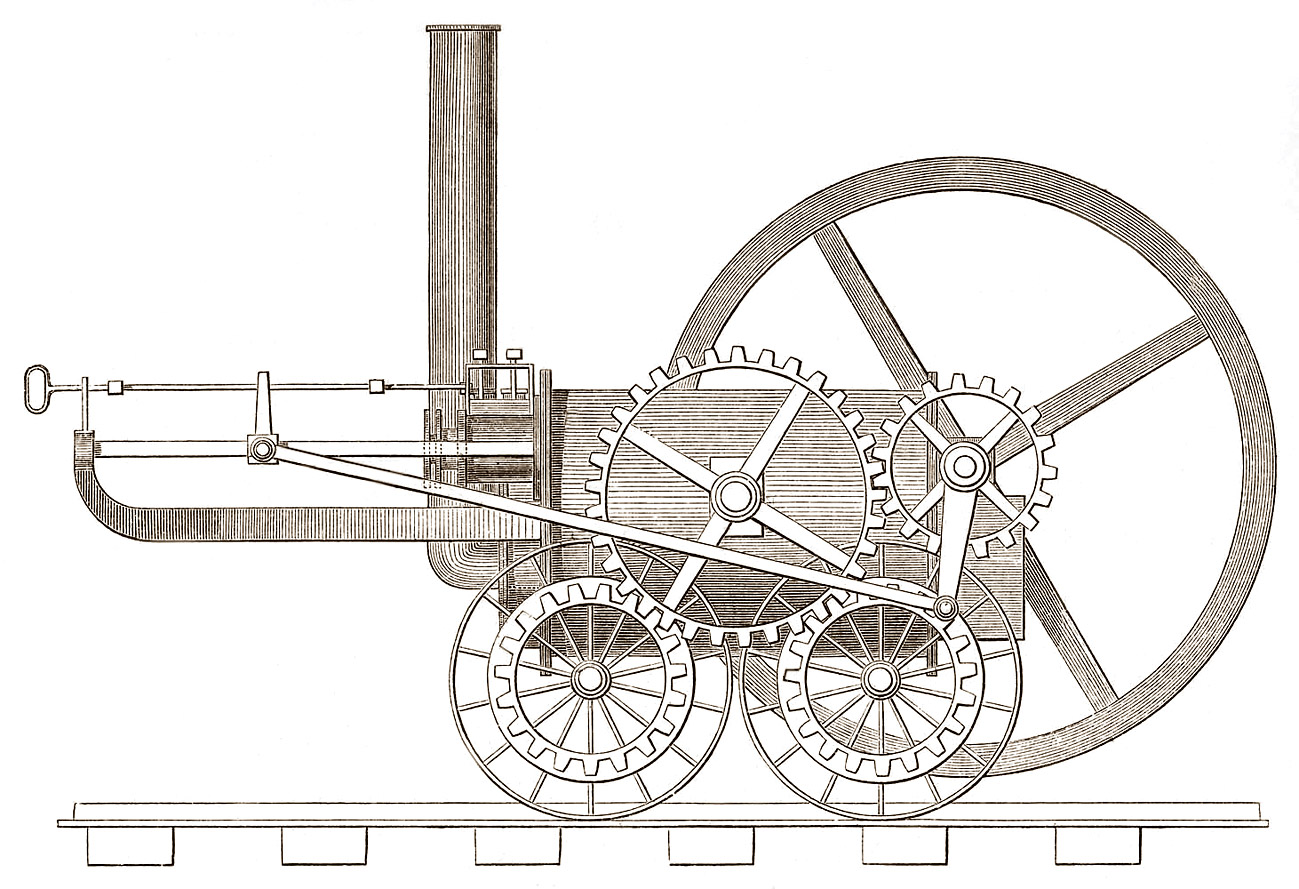
Schemat lokomotywy parowej skonstruowanej przez Richarda Trevithicka - 1803 r.
ZMAGANIA KÓŁ Z SZYNAMI
Nowe wynalazki często napotykają na swojej drodze do doskonałości różne przeciwności. Dla parowozu jedną z nich było… dopasowanie koła do szyny. Problemem dla pierwszych parowozów był zbyt mały ciężar adhezyjny, zły stan szyn i nawierzchni. Rozwinięciem idei zmniejszania ciężaru lokomotywy było wprowadzenie dodatkowej, karbowanej szyny, która miała służyć do napędzania maszyny. Autorem tego pomysłu był w 1811 roku John Blenkinsop. Jeszcze śmielsza wizja zakładała zainstalowanie specjalnych, naśladujących zwierzęcy chód, mechanicznych łap, które miały nadawać lokomotywie odpowiedni ruch. Wehikuł taki skonstruował William Brunton w 1813 roku.
Pierwszy funkcjonalny parowóz
Żadne z tych rozwiązań nie odniosło jednak sukcesu. Powrócono zatem do porzuconej koncepcji wykorzystania naturalnej przyczepności koła do szyny. Była to przede wszystkim zasługa Williama Hedleya, który przeprowadzonymi doświadczeniami wykazał, że warunkiem poruszania się pojazdów po gładkich szynach jest odpowiednio wielki nacisk na koła napędowe. Tak powstał, skonstruowany przez niego w 1813 roku pierwszy funkcjonalny parowóz adhezyjny o nazwie „Puffing Billy”, używany aż do 1862 roku.
Stephenson – maszynomistrz z kopalni
Niezależnie od Hedleya, budową parowozów zainteresował się George Stephenson, wówczas maszynomistrz kopalń węgla w Killingworth. Zdołał on nakłonić zarząd firmy do rozpoczęcia prób z lokomotywą swojej konstrukcji. Po uzyskaniu pozwolenia zbudował, w 1814 roku, dwuosiowy parowóz adhezyjny z kołami o średnicy 914 mm. Silnik parowy był identyczny jak w lokomotywie Hedleya. Jednak z powodu kiepskiej charakterystyki cieplnej (niedostateczna powierzchnia grzewcza, pojedyncza rura płomienna, zbyt słaby ciąg kominowy – nadmiernie szeroki komin: 510 mm), nie osiągnięto satysfakcjonujących rezultatów.
Stephenson jednak nie zniechęcił się. Ośmielony wynikami Hedleya, w 1815 roku, zbudował nowy parowóz, w którym koła, w celu zwiększenia adhezyjnej siły pociągowej, połączono sztywnymi łącznikami, które później zastąpiono łańcuchami. W następnej konstrukcji, z 1816 roku, Stephenson wprowadził resorowanie parowozu, omijając napęd za pomocą kół zębatych. To pozwoliło na zniesienie niebezpiecznych uderzeń, spowodowanych nierównościami toru oraz na równomierne rozłożenie nacisku na koła.
Nowe nie zawsze znaczy lepsze
Prawie każdy rok, aż do 1829, przynosił nowe typy parowozów, nieróżniące się pod względem wartości od poprzednich. Podejmowane próby polepszenia charakterystyki cieplnej kotła okazały się bezcelowe, bowiem za pomocą jednej rury płomiennej niemożliwe było uzyskanie odpowiedniej powierzchni ogrzewalnej. Ponadto, utrzymanie parowozu w ruchu, wskutek niedoskonałości części mechanicznych, wymagało ustawicznych i kosztownych napraw. Fatalny wpływ na eksploatację miał również ówczesny stan szyn, wykonanych z krótkich, lanych sztab żelaznych. Tory te, nie mogąc utrzymać ciężkich pojazdów, ciągle się łamały i zwiększały tym samym koszty utrzymania ruchu. Ponadto, nieproporcjonalnie wielka liczba styków zwiększała opory toczenia i nadwerężała – na skutek naprężeń dynamicznych – i tak niedoskonałe podwozia pojazdów.
Jednak mimo wielu przeszkód i krytycznych ocen zainteresowanie kolejnictwem stale rosło
Przełomem okazał się 1820 rok, który przyniósł ludzkości epokowy wynalazek. Wówczas to John Birkinshaw, inżynier huty żelaza w Durham, wprowadził do eksploatacji szyny walcowane – znacznie dłuższe niż poprzednio odlewane. Znalazły one zastosowanie przy budowanej przez Stephensona, w 1822 roku, pierwszej dłuższej linii kolejowej na trasie Stockton-Darlington, projektowanej, głównie, na potrzeby wywozu węgla z tamtejszego zagłębia do północnych portów angielskich.